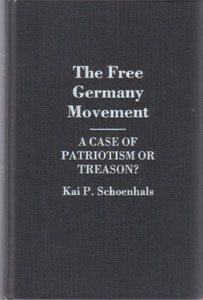| THE FREE GERMANY MOVEMENT A Case Of Patriotism Or Treason? Hardback Book Written by Kai P. Shoenhals Over 175 pages Copyright © 1989 by Kai P. Shoenhals " Few subjects relating to the Second World War have aroused such fierce controversy as the National Committee "Free Germany" (NKFD), an organization of German prisoners of war and Communist exiles who in 1943 established an antifascist movement on Soviet soil to overthrow Hitler. The Nazis, after first denying the existence of this movement, heaped abuse on its members, all of whom were condemned to death in absentia while their families faced internment in concentration camps. Unfortunately, these attacks did not end with the collapse of the Third Reich but continued in postwar West Germany where writers described the adherents of the National Committee as traitors and Communist dupes. " " A special organization for NKFD veterans existed in the German Democratic Republic from 1958 until March of 1972. This Arbeitsgemeinschaft ehemaliger Offiziere (Study Group of Former Officers) published a monthly Mitteilungsblatt (Information Bulletin) which contained reminiscences by former members of the National Committee Free Germany. These bulletins constitute a rich mine of information for any student of the NKFD. By terminating his account with the November 1945 dissolution of the Free Germany movement, Scheurig concluded that the organization was a failure. My own conclusion, however, is that the story of the National Committee runs far beyond the official date of its disbandment, and that any final estimate of its effectiveness must include the significant part played by the veterans of the NKFD in constructing the German Democratic Republic. One has only to think of the pioneering efforts made by former members of the National Committee in founding the GDR's NVA (National People's Army) and the NDPD (National Democratic Party of Germany) to realize the lasting effects of this movement. I have, therefore, devoted a chapter to the influence of the Free Germany movement on the developments in the Soviet Zone of Occupation (1945-49) and the GDR after October 1949. My aim has not been to take issues with Scheurig's work but to complement it by utilizing the considerable sources available in East Germany. A definitive study of the Free Germany movement, though, must await the opening of Soviet archives, a prospect that now, for the first time, seems possible. " Contents include: " Introduction 1. The Origin of the Antifascist Movement
2. The Founding of the National Committee Free Germany and the League of German Officers
3. Free - Germany The First Phase
4. Free - Germany The Final Phase
5. The Impact of the Free Germany Movement on the German Democratic Republic Conclusion
Bibliography
Index " This book is in very nice condition with minor edgewear.
There are several pages with some pencil markings written in the margins.
No torn or ripped pages. | 





 for 1 item(s)
for 1 item(s)

















